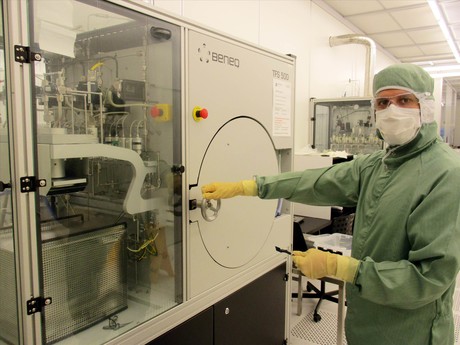Data-transmitting light signal gets power boost

Researchers from Aalto University and Université Paris-Sud have made a breakthrough in photonics, using a nanosized amplifier to improve the propagation of data inside a microchip.
Light is a more energy-efficient and faster way of transferring data than electricity. Until now, the rapid attenuation of light signals in microchips has prevented the use of light as a source of an information signal.
Now, researchers have developed an amplifier to help light signals propagate through microchips. Writing in the journal Nature Communications, the researchers show that signal attenuation can be significantly reduced when data is transferred inside a microchip, for example, from one processor to another.
“Photonics, or light transfer that is already widely used in internet connections, is increasingly being used by microcircuit systems because light is a more energy-efficient and faster way of transferring data than electricity,” said Aalto University doctoral candidate John Rönn. “The increase in information also requires an increase in performance. Boosting performance through electronic methods is getting to be very difficult, which is why we’re looking towards photonics for answers.”
The researchers made their breakthrough with the help of the atomic layer deposition method, which is apparently ideal for processing various kinds of microcircuits as it plays an important role in manufacturing today’s microprocessors. So far, the method has been used mainly in electronic applications; however, the newly released study indicates that possible applications also exist in photonics, where new components must also ideally work with electricity — that is, in electronics.
“Silicon is a key material in electronics, and that’s why it’s also included in our light amplifiers together with the amplification element erbium,” Rönn said.
“Today’s compound semiconductors, which are used, for instance, in LED technology, can also be used effectively in light amplification. That being said, most compound semiconductors are not compatible with silicon, which is a problem for mass production.”
The study showed that a light signal can be potentially boosted in all kinds of structures and that the structure of a microchip is not limited to a specific type. The results indicate that atomic layer deposition is a promising method for developing microchip photonic processes.
“Our international collaboration made a breakthrough with one component: a nanosized amplifier,” said Aalto Professor Zhipei Sun. “The amplification that we got was very significant. But we’ll still need more components before light can completely replace electricity in data transfer systems. The first possible applications are in nanolasers, and in sending and amplifying data.”
Please follow us and share on Twitter and Facebook. You can also subscribe for FREE to our weekly newsletter and bimonthly magazine.
3D semiconductor chip alignment boosts performance
Researchers have developed an ultra-precise method to align 3D semiconductor chips using lasers...
Researchers achieve 8 W output from optical parametric oscillator
Researchers have demonstrated a total output power of 8 W from a high-power mid-infrared cadmium...
"Dualtronic" chip for integrated electronics and photonics
Cornell researchers have developed a dual-sided chip known as a "dualtronic" chip that...






